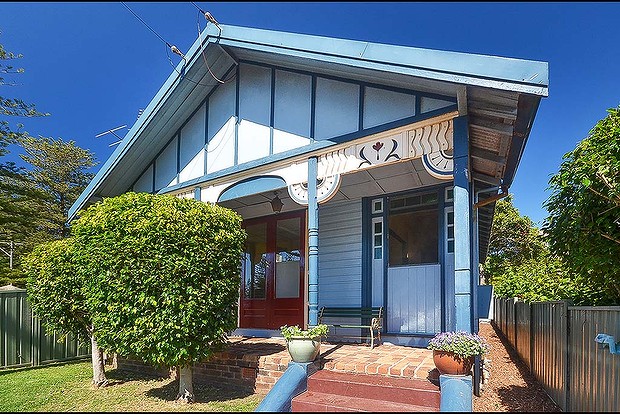Haberfield, the Garden Suburb of Sydney
- See also: Haberfield Federation Pride
- See also: Boomerang Street, Haberfield
- See also: Haberfield Arts & Crafts Style
- See also: Haberfield Gardens
- See also: Haberfield Timber Decoration
- See also: Haberfield Fencing
- See also: Gothic Queen Anne style
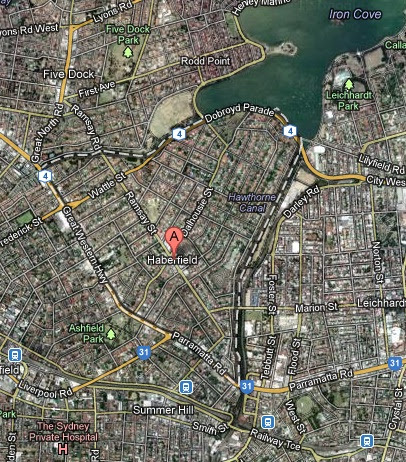 |
| Haberfield, 5 Km west of Sydney |
Haberfield sits south of Iron Cove, part of Sydney Harbour.
- The main road is Ramsay Street and the point of land that faces Iron Cove, Dobroyd Point, is a historical locality of Sydney.- From Wikipdedia:
Garden Suburb
When first established in 1901 Haberfield was marketed as the ‘Model Suburb’.
- Being based upon the City Beautiful Movement, Haberfield soon become known as the ‘Garden Suburb‘ by the early decades of the 20th century.
- Today Haberfield retains its key ‘garden suburb‘ concepts in its tree-lined streets, neighbourly gardens and period architecture.
- The entire suburb is heritage-listed as a Conservation Area and is part of the Register of the National Estate of Australia– http://www.ashfield.nsw.gov.au/page/haberfield.html
“The present day character of Haberfield was established between 1901 and 1917 with the subdivision and development of the Ramsay Family’s Dobroyde Estate (Ramsay’s Bush) by Richard Stanton.
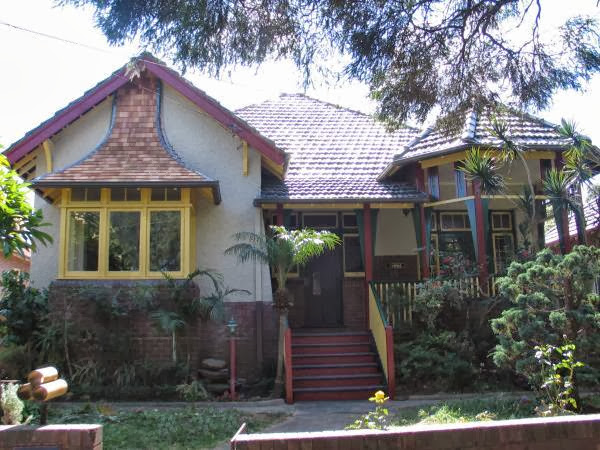 |
| Federation Elegance , ‘Curra, Sunnybrae’ (1928) 14 Kingston Street, HABERFIELD |
- In 1901, landholder Richard Stanton bought 50 acres (200,000 m2) from two Ramsay children and subdivided the area to create a garden suburb.
- Richard Stanton opened his first Haberfield Estate in 1901. Two years later, the second estate, based on Stanton and Haberfield Roads, was opened.
- Sydney had recently suffered outbreaks of the bubonic plague in overcrowded parts of the inner city and the garden suburb movement was a response to that, encouraging fresh air. He also claimed the development to be “slumless, laneless and publess”.
- The houses were designed by the architectural firm Spencer, Stansfield and Wormald.
- Stanton named the suburb ‘Haberfield’, after the English branch of his family. The fact that the development started in 1901 and a number of the early streets were named after prominent federal politicians has led to the suburb also being known as ‘The Federation Suburb‘.
Haberfield is a good-looking neighbourhood, says McGrath agent Michael Tringali, and one with a rare sense of unity and pride that you don’t always see in other suburbs.
- “People look out for each other and there’s a sense of community shared by the shopkeepers and restaurateurs, some of them have been running family businesses here for years,” Tringali says.
- “The heritage restrictions mean the suburb will stay low density and continue to be very attractive for professional families working in the CBD,” he says.
 |
| 40 DalhousieStreet Haberfield |
 |
| Haberfield in detail. |
Ray White agent Henriette Masmeyer agrees. “All the streets are wide and tree-lined and what you get now will still be here in another 20 years time,” she says. “The green space Haberfield is hanging on to will be highly prized in years to come.”
- Of course, the heritage status comes with limitations for those keen to extend and renovate as all new work must be in keeping with the character of the suburb’s existing streetscapes.[1]
Haberfield Prices
When inner westies gather to talk real estate, the subject of Haberfield is often raised. Heads shake and there are mutterings about the ”ridiculous” results, especially when compared with prices back in the day, be that the 1980s, 1990s or 2011.
Examples include the $2.91 million in April for a four-bedder a few doors from Parramatta Road. Or the $2.8 million in December 2011 for an unrenovated four-bedder, with only one bathroom, on Turner Street. And the unrenovated two-bedroom semi on busy Dalhousie Street that sold on the quiet in November for $1.2 million.
McGrath Inner West agent Michael Tringali explains the attraction: ”Consistency of architectural integrity draws a very house-proud demographic who are prepared to stay for the next 15 years to raise their family, while they restore or maintain their home’s Federation character in the knowledge that a two-storey McMansion won’t pop up next door.”
This sentiment has meant the median house price has soared 66 per cent in the past decade, almost double the Sydney-wide growth of 35 per cent. As LJ Hooker Haberfield agent Peter Sotiropoulos says: ”Prices have pretty much doubled every 10 years since our first boom in 1978.”[2]
Haberfield Heritage’s photostream (83)
|
|
|
|
|
|
|
Haberfield Heritage
- “Approximately 1500 houses were constructed in this and adjoining areas to designs by J Spencer Stansfeld and D Wormald.
- “Stanton applied a covenant on the land titles for lots in the Dobroyde Estate stipulating building setbacks and materials for each house to be constructed, which assured all owners that nearby development would be of similar quality.
 |
| Aerial view of Haberfield in Sydney |
‘Haberfield espoused the philosophy of the Garden Suburb with its gardens containing distinctive planting, fences, gates and curving tiled paths. Houses in Haberfield were typically ‘detached’ double-brick dwellings situated on their own block of land measuring 50′ x 150′ (15 m x 45 m). No two houses were alike, although there were many common themes throughout the suburb. The roofs were either slate or Marseilles tile. All had front verandahs. Decorative features typically used in this area include leadlight windows depicting Australian flora and fauna, Art Nouveau timber detailing and tuckpointed brickwork. – from: http://www.heritage.nsw.gov.au
The majority of houses in Haberfield are protected under a ‘heritage order’, which is the main reason why so many original Victorian and Federation houses still exist in the area.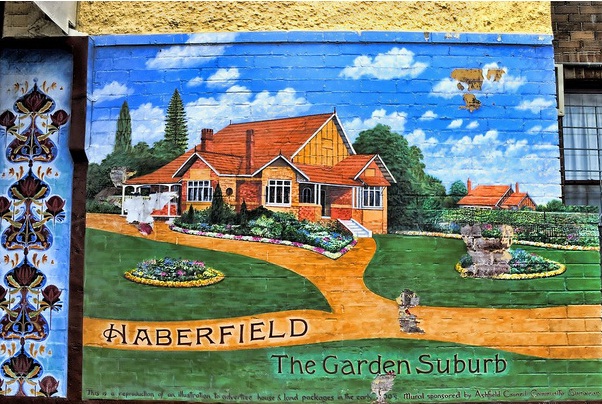
- Renovations and additions to both houses and properties must follow strict guidelines ensuring they stay true to the era’s style.
- Some examples of rules include: banning the addition of second storeys unless in the existing roof space, banning the demolishing of any protected houses, ensuring a 50:50 ratio of ‘hard surface’ to ‘soft surface’ on the property, ensuring house exteriors are painted in federation colours. Houses must also have a roof consisting of terracotta or slate tiles.
“This visionary social experiment was so financially successful that it helped lock in the great Australian dream of the quarter-acre suburban block with dwelling, which has dominated how Australians seek to house themselves.
“There are many reasons why Haberfield is significant at both a state and national level.
- It is more than the picturesque aesthetics of its streets, shops and single-storey houses, which, while predominantly in the Federation, and California Bungalow styles, cover the whole range of twentieth century architecture, including Federation Arts and Crafts and simple Arts and Crafts styles.
- Haberfield is a research repository of Federation-era architectural details, house layouts, utility provision, garden design and plant material, and the early planning of public infrastructure. – from Dictionary of Sydney
Three of the best in Haberfield
1. 40 Dalhousie Street Haberfield
- $4 million +; 6 bed, 5 bath, 4 car; Built 1907; renovated 2000s; Land: 1526 square metres
- Inspect by appointment Agent: McGrath Inner West, 0408 000 100
- Last traded for $1.79 million in 2002 – More photos: Domain.com.au
 |
| 40 Dalhousie St Haberfield |
There are in fact two homes on this large, level block, ideal for extended family or guest accommodation. The main residence is a substantial Federation home melding both the Arts and Crafts and Queen Anne styles to create an impressive property retaining plenty of original features.
- High ceilings with decorative roses, marble and timber surround fireplaces, picture rails and leadlight windows are all showcased in both the bedrooms and the grand formal living spaces. A handsome arched window in the dining room faces onto the deep front porch and there are large bay windows in the front rooms.
- A modern stone and gas kitchen has plenty of storage and adjoins the casual dining and family room. It opens onto a covered, wrap-around verandah and a garden with palm-fringed pool.
- The master bedroom has a built-in wardrobe and a modern en suite and the family bathroom has a separate w/c. There is a second bedroom on this level and two more bedrooms upstairs, where you’ll also find a sitting room and storeroom and a third bathroom.
- The second residence was built in the 1990s and has generous open-plan living spaces, a gas kitchen, a large main bedroom with en suite and wardrobe and a smaller second bedroom.
There is a side driveway to a substantial four-car garage and plenty of lawn for backyard cricket.
- Room for improvement: The blue carpet has to go!
2. 9 Forrest Street Haberfield
- $3.5 million + ; 5 bed, 3 bath, 3 car; Built circa 1930; renovated 2011; Land: 938 square metres

9 Forrest St Haberfield - Inspect Sat, noon-12.45pm; Wed, 6.30pm-7pm; Agent: Cobden & Hayson, 0413 672 287
- Auction: April 18; Last traded for $1.48 million in 2007 ; More photos: Domain.com.au
If you’ve just done a double-take looking at the photos of the front and rear facades of this property, you’re not the only one. From the street, the facade blends seamlessly with its Federation neighbours, as per heritage orders. But out the back a cutting-edge extension adds a dramatic modern dimension with inclusions for the serious home cook, wine connoisseur and movie or sports buff.
- The original part of the house hosts four bedrooms including an indulgent master with concealed access to a large walk-in wardrobe and a stylish en suite. In the new wing, the eye is drawn past the marble-topped kitchen to a split-level living room with built-in daybed and access to a covered balcony. American oak flooring adds warmth alongside a feature wood fireplace.
- Downstairs, you’ll find a fifth en suite bedroom and en suite, and a large games room with projector and retractable movie screen, plus access to a temperature-controlled 3000-bottle wine room.
Outside the old and new sit side-by-side: the original stables, ideal as garaging, storage or as a workshop or studio forms the northern boundary of a glass-framed, gas-heated pool.
- Room for improvement: Sand and polish the floorboards in the front bedrooms.
3. 253 Ramsay Street Haberfield
- $1.688 million; 3 bed, 3 bath, 2 car; Built circa 1910; renovated 2010; Land: 695 square metres
- Inspect: Sat, 10am-10.30am; Agent: Ray White Haberfield, 0419 243 399; Last traded for $970,000 in 2009
| 253 Ramsay Street HABERFIELD |
If you can live with the location on busy Ramsay Road you’ll get more value for your dollar at this renovated family home. The house on the back boundary in Martin Street on a comparable block sold for $1.9 million in 2013. The front two bedrooms of this property face the street and are surprisingly quiet. Each bedroom has a built-in wardrobe, the master with an en suite.
- The modern bathroom has floor-to-ceiling tiles and a rain shower and there is a third bathroom at the back of the house with a bath and laundry facilities. A central lounge room with a decorative timber and cast iron fireplace leads through to a study and open-plan living spaces with a stone and gas kitchen featuring stainless steel appliances. Bi-fold doors open onto a large, partially covered deck which steps down to the back garden and a solar heated pool. One half of the double garage has been converted into a self-contained studio.
- Room for improvement: Widen the window in the study to provide more natural light
Leadlight Stained Glass at 160 Bland Street Haberfield
 |
| Beautiful Art Nouveau leadlined glass door and transom sets |
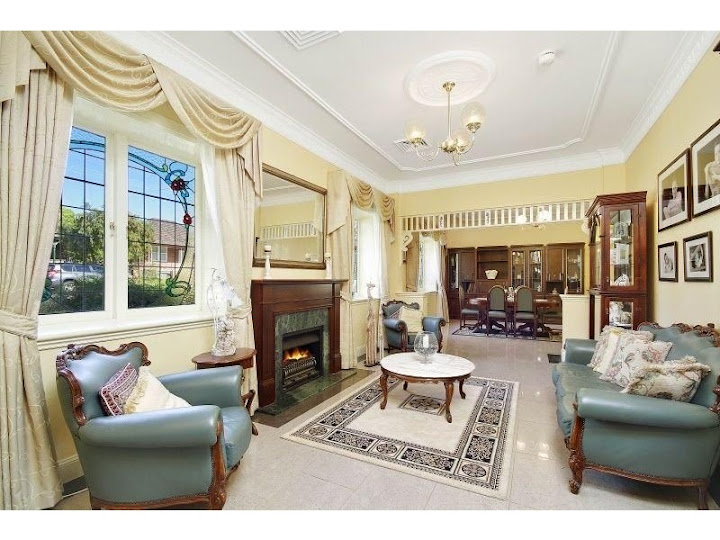 |
| Beautiful Art Nouveau leadlined glass casement windows |
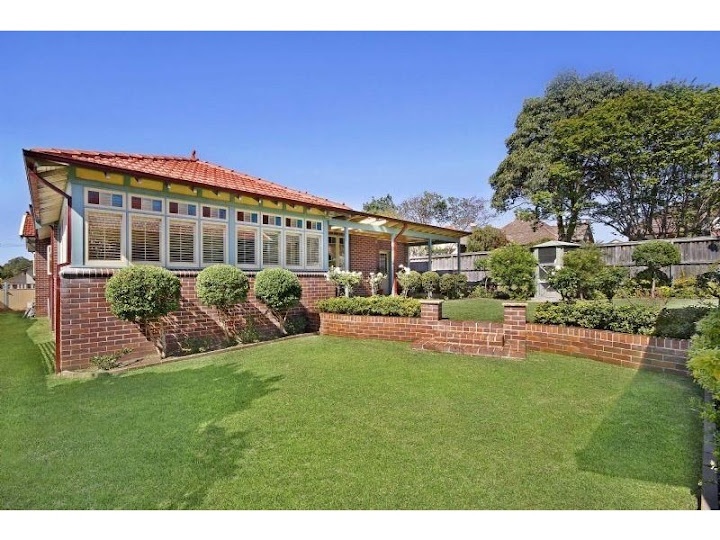 |
| Coloured glass transom windows above casement windows |
